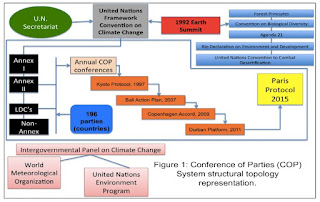Again I am
going to start with a video, a nice animated summary what the COP21 actually
is.
In general,
COP21 means it is the 21st Conference of Parties on climate change.
196 representatives of different nations are sitting together and discussing
the environmental future of our planet. The main goal is to stabilize the
concentration of greenhouse gas at an, for our environment healthy level, to
decrease climate warming. The plan is to stay under 2 degrees Celsius of
warming until 2100. This boundary value is set at the critical level of
irreversible changes to our environment. Most scientists are presuming with a
greater warming than 2 degrees, the positive feedback reaction, like the
melting of permafrost (release of CO2 and Methane) or the degradation of the
artic ice shield (reducing of the albedo), might be unstoppable. Therefore,
many people are seeing the COP21 as a last resort to stop climate warming. The
figure below is stressing this point, but showing at the same time the
unsuccessful history of climate conferences.
Figure 9: Eichholz 2015
But maybe
even because of so many previous conferences, the chance of success is this
time much higher. In addition, a strong argument is the willingness of China
and the US to reduce their emissions. Both are at the moment the strongest
pollutants, China because of its intense economy growth and the high population
and the US with the by far highest per capita CO2 air pollution. (The WorldBank 2015)
What are
the possible results of the COP21?
I found a
nice figure, which shows three possible scenarios.
Figure: 10 Eichholz 2015
· Scenario 1: The conference will
produce a protocol, which is binding and excepted for all parties to stay under
the critical level of 2 degrees Celsius of warming. This will enhance the
energy change in the direction of renewable energies and encourages investment
in this sector. The best-case scenario for our environment, but unfortunately
not that likely.
· Scenario 2: The conference will
produce a partly agreement, which will lead to reduced CO2 emissions, but will
not be able to stay under the boundary value of 2 degrees Celsius. I presume
this will be the most likely scenario. Because even if every nation is
motivated to reduce their CO2, it is going to be an expensive and complicated
development, in particular for developing countries.
· Scenario 3: The negotiations will
fail. There will be no contract or protocol, which would mean business as
usually and would lead to a temperature rise of over 4 degrees Celsius.
(Eichholz 2015)
Even
though, most people are hoping for scenario 1, there are many critics and
pessimistic views, for example at this environmental blog. The author doesn’t
really believe in the success of this event and says that it is just a show run
for politicians. He encourages the economy to look at the profitable
opportunities, which could arise through a global energy change.
To
conclude, at my opinion COP21 implicates a great opportunity to finally set
some real guidelines to preserve our climate. And I am really hoping that is
going to be more like a show for the public and that they will achieve an
international treaty, without ending up with the usage of Geoengineering
methods.


Keine Kommentare:
Kommentar veröffentlichen